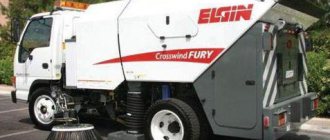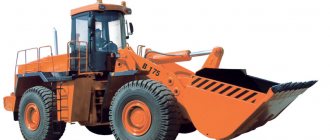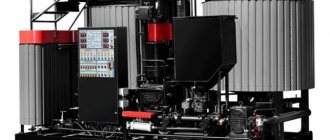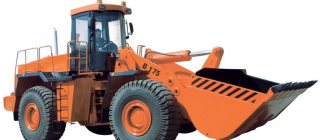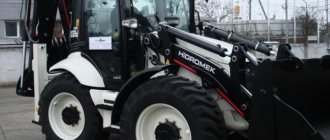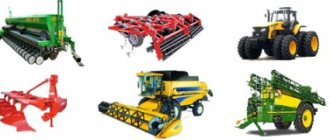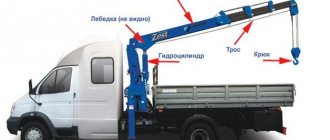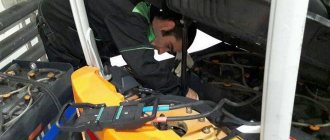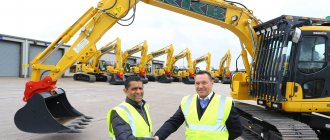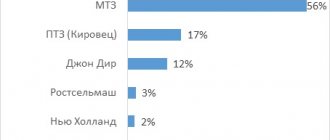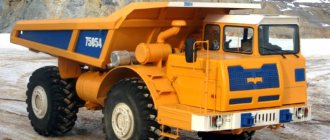To complete a construction project or pave a road efficiently and on time, you will need special equipment. Its design features and functionality should be taken into account in order to maximize the potential of the machines and not increase costs.
Road construction equipment includes:
- Backhoe loaders.
- Graders.
- Road rollers.
- Bulldozers.
- Excavators.
- Telescopic loader.
- Automotive cranes, etc.
Road machines are designed for the construction and maintenance of roads for various purposes:
- Highway.
- House and intra-block roads.
- Sidewalks.
- Runways.
- Pedestrian and bicycle paths, etc.
History of the development of road construction machines
In the history of technology development, one can trace the stages of improvement of power units of machines and equipment for them: from horse traction to a steam engine, from the simplest blade to a hydraulically controlled bucket.
Technologies are moving towards improving control automation systems, using high-precision sensors to monitor the technical condition of equipment and the quality of work performed, and using computing modules to process information about the state of operating parameters.
Although the design of the diesel engine, gearbox, and final drive of the axle remains unchanged.
The first excavator and further changes in design
Interesting to know! The first excavator was developed by William Otis in 1836. It had a steam engine, was low-power (up to 20 hp), and due to its design features it could only turn 180⁰.
Significant stages in the development of earthmoving equipment were the introduction of a hydraulic system, tracks, internal combustion engine, and electric motors. The machines continue to improve in the areas of control and monitoring systems, production of mini-models, performance and reliability of hydraulics.
Bulldozer: the beginning of development to the present day
The prototype of a modern bulldozer blade was a frame with a cutting metal blade, which was used for cultivating land and building housing. This device was driven by a team of mules or horses, which pushed it in front of them. As tracked tractor technology developed, a blade was adapted to it, the angle of inclination of which was first set manually. By 1935, engineers were able to successfully implement a hydraulic system to control a shovel .
Another technologically important breakthrough in the development of bulldozers was the use of a torque converter in the transmission. With its help, it is possible to achieve maximum traction on the tracks, which is important when performing heavy work, including on frozen soils.
The development of bulldozer equipment occurs in the plane of reducing repair costs, increasing efficiency, efficiency, maintainability, comfort and ergonomics of the operator’s workplace.
A group is a division of machines that are similar in operating principle.
A subgroup is a division of machines united by a principle of operation, a method of performing a technological operation, a design diagram, limited by the values of the main parameter.
Species - a variety of a given subgroup.
Subspecies is a variation of a given subspecies, differing in design, for example, of a running device. Index - a specific designation of a machine model of a given subtype.
Classification schemes for machines for excavation work, as well as lifting machines, are shown in Fig. 1.2 and 1.3.
All machines used for construction and installation work are divided into: construction machines and road machines.
Road ones include: soil mixers, milling cutters, seam cutters, road mixture distributors, asphalt pavers, base profilers, asphalt spreaders.
Table 1.1 Classification of construction and road machines using the example of excavators and jib self-propelled cranes
A separate group consists of manual, pneumatic and electric machines, i.e. mechanized tool.
The basis for the enlarged classification of construction equipment is the purpose of the machines.
Based on their purpose, they are divided into subclasses: I. Machines for excavation work. II. Lifting and transport machines. III. Machines for drilling operations. IV. Machines for piling work. V. Machines for concrete and reinforced concrete works. VI. Machines for finishing work. VII. Road cars. VIII. Manual machines (mechanized tools).
A more detailed classification of machines is also carried out according to design, type of working element, possibility of movement, type of drive, degree of rotation, method of support.
In addition, there is a general classifier that determines the purpose and place of construction and road machines.
All of them, according to the temperature range at which they retain their functionality, are divided into two groups: - general-purpose machines designed to operate at a temperature of ±40 ° C (version U); — special machines, special designs, designed to operate at temperatures up to -60 °C (version UHL) and machines for operation at temperatures up to +60 °C (version T).
A classification of load-lifting cranes according to operating modes is provided.
Use classes CO ... SE have also been established depending on the number of operating cycles of the crane during its service life, immersion classes 0 ... 4 depending on the load factor and a group of crane operating modes depending on the class of use and load class.
The breakdown of machines into their component parts - assembly units - is depicted using classification schemes that make it possible to visualize the design of machines in this group, including running gear, drive, working equipment and working parts, type of suspension, control system.
The classification schemes cover machines and tools used in construction in general, as well as machines used for mechanization of certain types of work: preparatory, excavation, piling, installation and vertical transport, loading and unloading work.
Machine indexing is a conventional alphanumeric designation (index), reflecting the machine model and its main parameter.
The general alphanumeric designation of machines is provided for by GOSTs. However, machine indices assigned to them by manufacturers sometimes differ from GOST ones.
For excavators, jib and tower cranes, a combined indexing has been adopted, including the following characteristics: 1st digit - size group, 2nd - type of running gear. 3rd - design of working equipment, 4th - serial number of the model. The letters in the index that come after the numbers indicate the next modernization (A, B, C, P..); climatic version (UHL - cold climate, T - tropical, TV - tropical wet; cars for temperate climates do not have this designation).
The division of construction and road machines into main groups is given in Table. 1.2.
The following designations are provided for tower cranes: Г—for hydraulic engineering (KBG); R - for building repairs (CBD); M - modular cranes (KBM).
Number of size group of tower cranes (nominal load moment, t-m), 1st - up to 25; 2nd - 60; 3rd - 100, 4th - 160, 5th - 250, 6th - 400, 7th - 630, 8th - 1000, 9th - more than 1000.
Model serial numbers for cranes with rotating and fixed towers are 01 ... 69 and 71 ... 99, respectively.
Sometimes construction ministries and departments assign their own indices to cranes: SKG-401 - special crawler crane with a lifting capacity of 40 tons, 1st model; MKG-25BR - crawler installation crane with a lifting capacity of 25 tons, tower equipment, with sliding trolleys; DEK-252 - diesel-electric crane with a lifting capacity of 25 tons, 2nd model; MCK-I0-20 - special installation tower crane with a lifting capacity of 10 tons, reach 20 m; MK.P-25 - pneumatic wheeled assembly crane with a lifting capacity of 25 tons, MKTT-100 - assembly crane with a telescopic boom based on a tractor, with a lifting capacity of 100 tons, M CAT-40 - automobile assembly crane with a telescopic boom, with a lifting capacity of 40 tons; SMK-12 is a special erection crane with a lifting capacity of 12 tons, ABKS-6 is a truck-mounted tower crane for rural construction with a lifting capacity of 6.3 tons.
Table 1.2 Main classification groups of construction machines
The following indices have been assigned to passenger-and-freight lifts: PGS-800 - a lift with a lifting capacity of 800 kg; MGPS-1000 is a mobile cargo-passenger construction hoist with a lifting capacity of 1000 kg.
Car lifts and towers are indexed differently: AGP-28 - car hydraulic lift, lifting height 28 m; VS-18 - construction tower, lifting height 18 m.
For other groups of construction machines, equipment and tools, the following letter designations are established: ETR - rotary trench excavators; ETC - chain trench excavators; DZ - bulldozers, scrapers, motor graders; DU - machines for soil compaction; SP - machines and equipment for piling work; BM - drilling and drilling crane machines; SB - equipment for concrete work; SO - machines and equipment for finishing work, flooring and roofing work; TO - single-bucket loaders; TA - machines for unloading cement; TR - non-metallic unloaders; TP - construction mast lifts; GGP - cargo-passenger lifts; TC - cement trucks; tools (hand machines): IE - electric, IP - pneumatic.
—-
During the construction of heat and gas supply systems, water supply and sewerage networks and structures, a large number of construction machines are used that differ in purpose, design, parameters and power.
Construction machines are classified: by the type of work performed (by technological characteristics); by operating mode; by the type of energy used and the type of power equipment; according to the degree of mobility and degree of versatility.
According to the type of work performed, construction machines are divided into the following groups: lifting; transporting; loading and unloading; for excavation work; for drilling operations; for piling works; for processing and sorting stone materials; for the preparation and transportation of concrete and mortar mixtures and compaction of concrete mixtures; for finishing work; for pipe processing (pipe cleaning and pipe insulation); manual for installation and assembly work.
Each group of construction machines can be divided into subgroups that unite machines within a narrower range of work they perform (for example, lifting machines include cranes and hoists). Each subgroup, in turn, combines machines of separate types, differing in the design of individual components or machines as a whole (for example, trench excavators are divided into rotary and chain).
Each type of machine has several standard sizes (models), similar in design, but differing in the capacity of the working body, load capacity, dimensions and weight, productivity, power of the power plant and other data.
According to the operating mode, a distinction is made between periodic (cyclic) machines, which produce work by periodically repeating the same cycle (including working and idle operations), and continuous machines. The first group of machines includes construction cranes, hoists, single-bucket excavators, etc., the second group includes multi-bucket excavators, conveyors, pumps for pumping mixtures, etc.
By type of energy used and type of power equipment
There are machines driven by internal combustion engines, electric, hydraulic, pneumatic, and steam engines. Mixed drive systems are also used - diesel-electric, diesel-hydraulic, electro-pneumatic, etc.
According to the degree of mobility, machines are divided into stationary, portable and mobile (trailed and self-propelled).
According to the degree of versatility, a distinction is made between universal machines, equipped with several types of replaceable working equipment to perform various technological operations (single-bucket construction excavators, cranes, loaders, etc.), and specialized machines, designed to perform only one type of work (pipe cleaning and insulating machines, mortar - and concrete pumps, etc.).
—
Many tens of thousands of machines of various sizes are used in construction. According to their production (technological) characteristics, they can be classified into: lifting, transport, loading and unloading, earthmoving, drilling, piling, crushing and screening machines, machines for reinforcement work, mixing machines, machines for transporting concrete mixtures and solutions through pipes, equipment for laying and compaction of concrete mixture, finishing, mechanized construction tools.
In addition to the listed groups of machines, there are others, but they are not discussed in this course, since their study is not provided for in the program.
Each group of machines can be divided into subgroups.
For example, the group of earth-moving machines includes: a) excavators (single-bucket and multi-bucket); b) earthmoving and transport machines (bulldozers, scrapers and motor graders); c) equipment for excavation work using the hydromechanization method (hydraulic monitors, dredgers and suction dredgers).
Single-bucket excavators, in turn, can be classified according to purpose, bucket capacity, working and running equipment and other characteristics.
Detailed classification within groups of machines is given in the corresponding chapters and paragraphs of the textbook.
Types of road construction equipment and their purpose
A telescopic loader is used to perform a range of tasks:
- Raising people.
- Leveling the surface.
- Planning a site for construction of facilities.
- Transshipment of bulk and other cargo, etc.
With the help of a motor grader, the foundations for highways, construction sites, parking lots, etc. are prepared with high precision.
With the help of a bulldozer and an excavator , construction sites are planned, soil is excavated and moved. Particularly high productivity and speed of performing these operations is achieved when this equipment works together on site.
Dieci telehandlers
The line of Italian telescopic loaders Dieci includes such models as:
- Dieci Samson 45.8.
- Dieci Apollo 25.6.
- Dieci Zeus 37.7.
- Dieci Dedalus 30.7.
- Dieci Samson 75.10.
- Dieci Zeus 38.10.
- Dieci Icarus 40.17.
- Dieci Icarus 40.14.
The reversible hydrostatic transmission with a variable displacement pump, installed on Dieci loaders, is paired with a two-speed gearbox.
Also in the wide range of Dieci telescopic loaders there are models with hydrodynamic transmission (Power Shift). Thus, you can choose a telescopic loader model that is guaranteed to cope with the tasks.
The equipment can be equipped with a large number of attachments for construction, public utilities and agriculture, for work in quarries and in the forestry industry - more than 40 types of attachments in total.
SDLG front loaders
SDLG front loaders are assembled on a high-precision equipment line. Depending on the climatic, road or soil operating conditions, you can select the appropriate modification of the machine for certain operating conditions.
Important! High-tech Chinese SDLG loaders are lower in cost than their counterparts from Europe and with the same technical indicators allow you to save money when replenishing your fleet of equipment.
The loader frame is articulated and provides minimal rotation.
New Holland skid steer
New Holland mini loaders are available in both tracked and wheeled versions.
Due to its compactness and mobility, this equipment is used in conditions of limited maneuvering space. At the same time, the machines have all the qualities that full-size loaders have: productivity, interchangeable attachment, ease of operation, comfortable operator's workplace, reliability and durability.
Important! Road construction equipment, selected in accordance with the conditions of use and the types of work performed at the site, allows minimizing manual labor, speeds up the completion of work and improves its quality.
The concept of road construction equipment
Road construction equipment (DCT) refers to a wide group of mechanisms designed for the creation, repair and maintenance of highways, roadways within cities, local areas and sidewalks. This also includes road construction equipment, which provides a full cycle of operations for creating asphalt concrete and cement concrete pavements.
Tandem rollers
They are full-size representatives of the ARX class. Produced by most well-known brands. The weight of the rollers is 14-16 tons with a drum diameter of 1100 to 1400 mm. The larger diameter helps prevent wave formation when laying sensitive polymer-modified mixtures.
Standard operating functions are:
- possibility of simultaneous operation with two frequencies and two amplitudes;
- sealing at the junctions of hot and cold mixtures;
- work near buildings, in hard-to-reach places or on bridges (oscillation).
Modern models are also equipped with systems for determining the degree of asphalt compaction. This allows you to save on unnecessary machine passes.
Asphalt pavers
Available in a range from compact to super-heavy models. Their use significantly speeds up the speed of work, and leveling and pre-compaction systems make it possible to improve the quality of the canvas. Vögele has new models. These are the Super 1600-3i and Super 1603-3i (tracked and wheeled versions, respectively). They are compact machines and allow you to lay the mixture in a strip of 7 to 7.5 meters.
The super-heavy model Bomag BF-900C allows you to lay asphalt 13 meters wide. Also in this class are specialized models for laying sand, soil and lean concrete. They are equipped with reinforced conveyors and augers to minimize wear.
Compaction technology
The pace of development of the market for vibrating plates and vibratory rammers does not lag behind other types of road equipment. The Ammann APH 110-95 vibrating plate with a strip width of 950 mm has a hydrostatic drive, an operating weight of 825 kg and an penetration speed of up to 37 m/min. The advantage of this hydraulic vibrating plate is that the force can be adjusted based on the surface material and working conditions. The adjustment is made by changing the engine speed. The productivity of the vibrating plate is more than 2000 sq.m. surfaces per hour.
Volvo CE's intelligent compaction system allows you to calculate pavement density in real time. The basis of the system is a processor that makes calculations using a complex algorithm based on information from pressure sensors on the roller drum. Temperature sensors are also installed on the skating rink. The operator runs a 10-meter test strip, after which the processor automatically calibrates the force based on the material and conditions.
Road milling machines
The working width is from 0.5 to 2 meters. the Bomag BM2000/75 road milling machine is 36 tons. The compact road milling machine Wirten W 50 Ri has a working width of 0.5 meters. For high-quality cutting of the surface, it uses a leveling system. All models are equipped with multiple snare drums.
Typically a set consists of three cutters:
- For large cutting depths;
- Standard;
- Finishing (used to remove thin cracks on the surface, without replacing the coating).
Designers attach great importance to reducing dust levels, for which they use various systems, for example, spraying a binder directly in front of the drum.
Compact compaction rollers
Models from Ammann, Bomag and Hamm weigh from 3 to 7 tons. They are characterized by compactness, a short wheelbase and a 1700 mm wide drum. The seven-ton Bomag BW 177 D-5 and BW 177 DH-5 have a drum extended to 1900 mm, which increases productivity by 11 percent.
Separately, it is worth highlighting the Bomag BW 11 RH-5 with a turning radius of 2.7 meters. This makes it possible to compact asphalt or soil in limited areas. The compaction quality is ensured by smooth start and stop. To control the rollers there are special backlit panels with a logically organized button structure.
